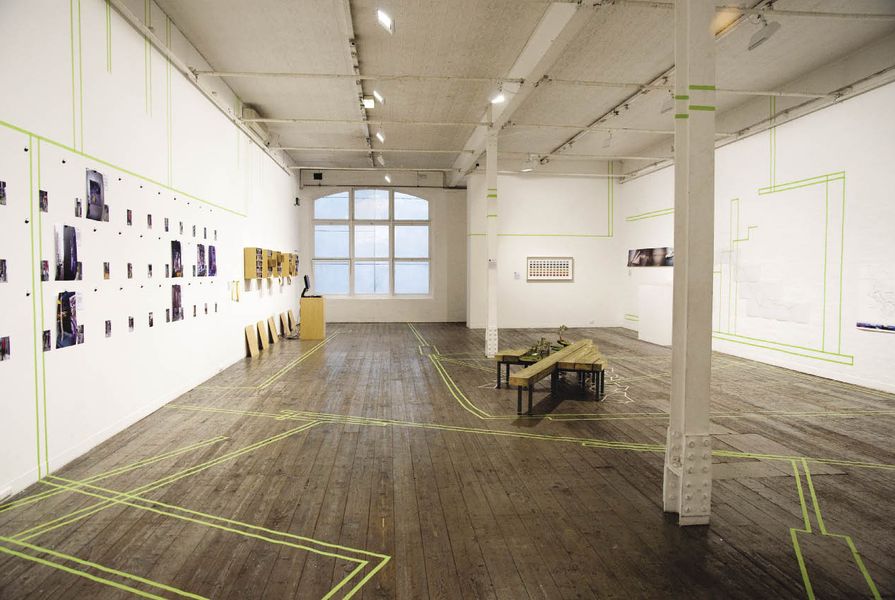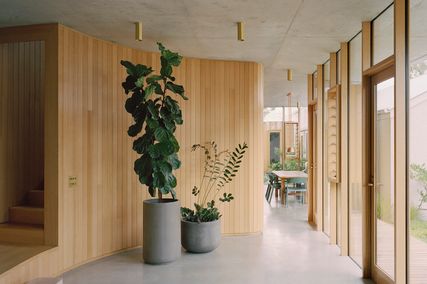Convened in association with RMIT’s Affirmative Architecture Symposium, the X-Field exhibition brought together the exploratory work of six practitioners, exposing ways in which contemporary designers work beyond and across disciplines.
“X-field” is an abbreviation of “expanded field,” a reference to Rosalind Krauss’s influential essay “Sculpture in the Expanded Field,” first published in October 1979 and revisited by Elizabeth Meyer in the locally influential proceedings of RMIT’s Edge 2 conference in 1992. Krauss’s, and then Meyer’s, reworked diagrams of the spaces in between poles of conventional practice have encouraged critical work by artists, architects, landscape architects and others for several decades.
But “x-field” might be read in other ways: as an “X marks the spot” of contemporary design practice; as the location for secret, cultish knowledge beyond the normal (“X-files”); as the locale of something inexpressible (x-factor); or as material suitable for mature persons only (X-rated). More simply, it might indicate something whose time is past: an ex-field. Once an open invitation to graze thoughtfully and chew the cud, Krauss’s field and Meyer’s ground are now well built upon by a clamorous, free-market invasion of indiscriminate structures, a cacophony of difference and diversity that claims equality without contestation, expansion without effort. Eschewing the easier, if more laborious, check-box correctness pursued by “good” design of more recent years (especially with regard to sustainability), these designers are interested in a wider dialogue about what being good is.
Cross-trans-inter-intra-disciplinarity is an easy enough bandwagon to climb aboard. Its precepts – collaboration, inclusiveness, hybridity, openness – have become the mantra of ubiquitous mission statements. Luckily, the designers of X-Field have remembered two things. You cannot predict what you get or avoid outcomes that will have their own problems, although you will get something different from business as usual. Also, there will still be a contest for what you want, though you may have a more generous range of options to consider. These acknowledgments seem a worthy outline for the task of design.
A collection of key works by the exhibitors is displayed in the first small room of the gallery.
The exhibition occupied two rooms. A first small room prefaced a bright open space beyond. The small room was an intricately curated jewel box of labelled objects, a series of overlapping vertical drawers, like an exploded cabinet of curiosities, carefully yet whimsically catalogued. The walls featured edited key works by the main room exhibitors, including machetes, mounted and digitally picture-framed images, and video and book publications, along with myriad other items, all literally footnoted with a decorative skirting board composed of a collective bibliography of influential texts.
The pieces of the main room shared a desire for intervention and interaction, linked to various types of transgression. In this design, research is most apparent and imperative: engagements, illicit in some way, requiring feedback as the material for analysis and proposition beyond what is expected or presently accepted. SueAnne Ware and Sand Helsel asked visitors to participate by taking items away with them and then returning some form of documentation – for Ware, a bottle of identified air and an image of its original location, for Helsel an image of a (likely illegally) self-billboarded poster. Charles Anderson’s contribution made use of material solicited from fellow designers, specifically sketched plans of remembered houses. His thought-provoking intention to examine our fraught longing for home in an age characterized by varieties of homelessness was not as easy to perceive in the taped outlines that wound through the exhibition as others’ intentions. Ware’s RAir Collection project was explicit:
I became obsessed with collecting air in 2008, partially because of very strict Australian customs regulations against bringing soil, rocks, seeds, or plant materials into the country, but mainly because of our hideously intolerant immigration policies.

Andrea Mina’s offering was a framed grid of painted matchboxes containing exquisitely crafted people and animals in tableaux of daily life. The whole display was reminiscent of commemorative teaspoon cabinets, thimble collections or Franklin Mint suburban collectables. But there was more here than witty handicraft. The colourful miniature figures were made from chewing gum found under the tables of RMIT’s architecture studios. Such doubly intimate bodily contact (I could almost smell their pretty peppermintiness) was a shock, as delightful as it was disturbing. For some visitors this was a cause of clearly vocalized discomfort, for others – perhaps inseparably – laughter.
Mel Dodd’s Diorama Bench is a literal, very sturdy seat of intricate modelled mappings of a contested public site. Here, park uses include “a world of transgressions, making cubbies, having fires and behaving badly.” She questioned “misuse seen as misbehaviour” and warned that planning policy comprehends public space as something to be filled rather than found, a much more difficult but necessary procedure and unavoidably provocative as well as political.
Mel Dodd’s Diorama bench.
Architect Richard Black’s extensive mappings of the ultimately unmappable flood plains of the Murray River elicited speculations that challenge “an interpretation of a site as a bounded piece of property,” an idea familiar to landscape architects through the work of Anuradha Mathur and Dilip da Cunha and again loaded with further questions of rights and responsibilities.
The value of this work to the problems of contemporary practice – beset by obligations and legislations to provide measurable value determined by others – is not simply as a creative outlet distinct from “real” paid work. This stuff is not just fun. Such exhibitions are certainly forums of resistance, as any alternative articulated reading of a situation is. More importantly, though, the articulation itself gives some purchase and hope to designers – and to everyone – that alternative understandings and outcomes might actually be possible. Even small purchases on possibilities that we can’t otherwise entertain are essential to two things: Firstly, they strengthen our knowledge of how thoughtful work is done. This is work happy to be guilty of frivolity, excess, banality or bad taste as long as it is also guilty of having an idea. Secondly, it also strengthens our resolve to do work which is very difficult but also ultimately unavoidable if we are to claim to be designers at all. The danger is not that we have stopped expanding our fields in response to critique and in pursuit of newly critical positions. Rather it is that there may no longer be any fields where critique is exercised and where critical work is actually permitted. X-Field is a bastion against ex-field.
Source

Discussion
Published online: 10 Dec 2011
Words:
Jo Russell-Clarke
Issue
Landscape Architecture Australia, February 2011






















